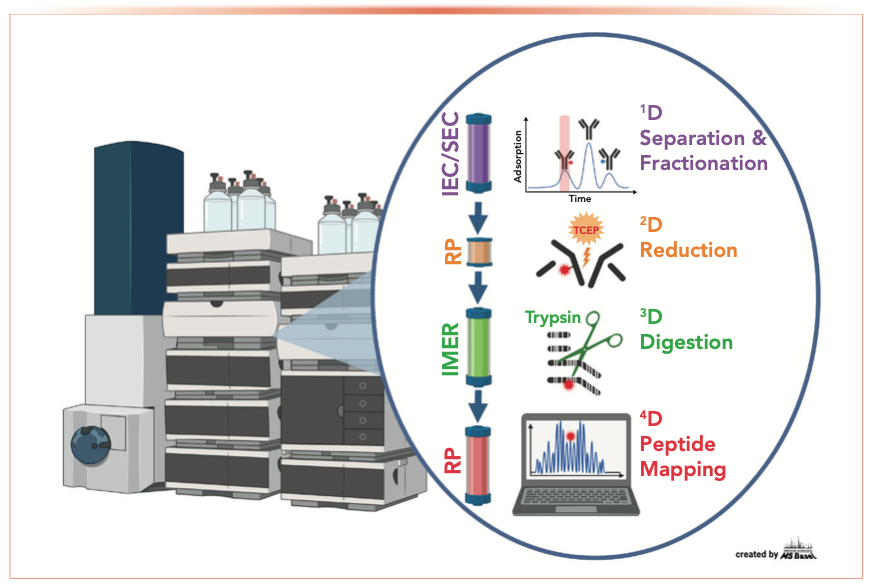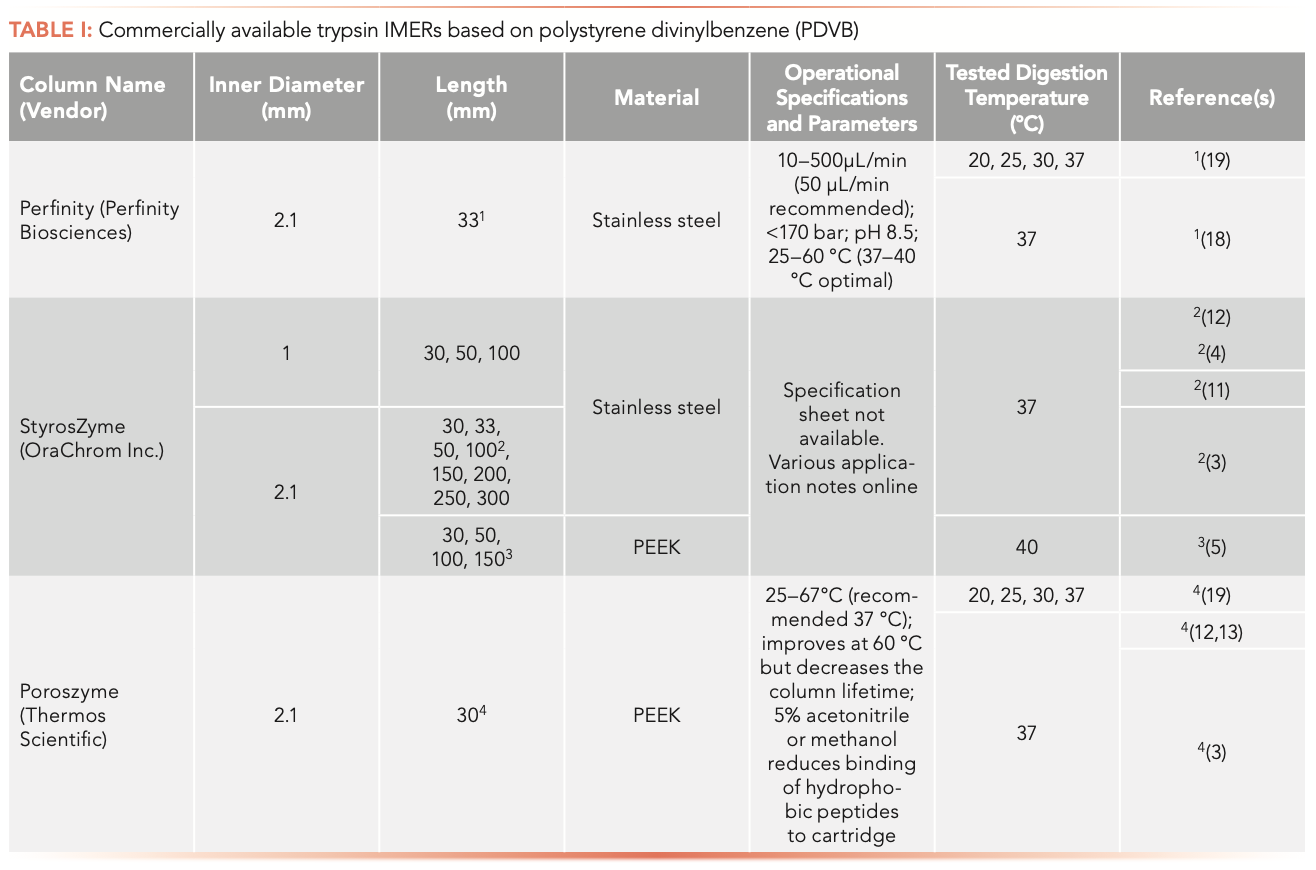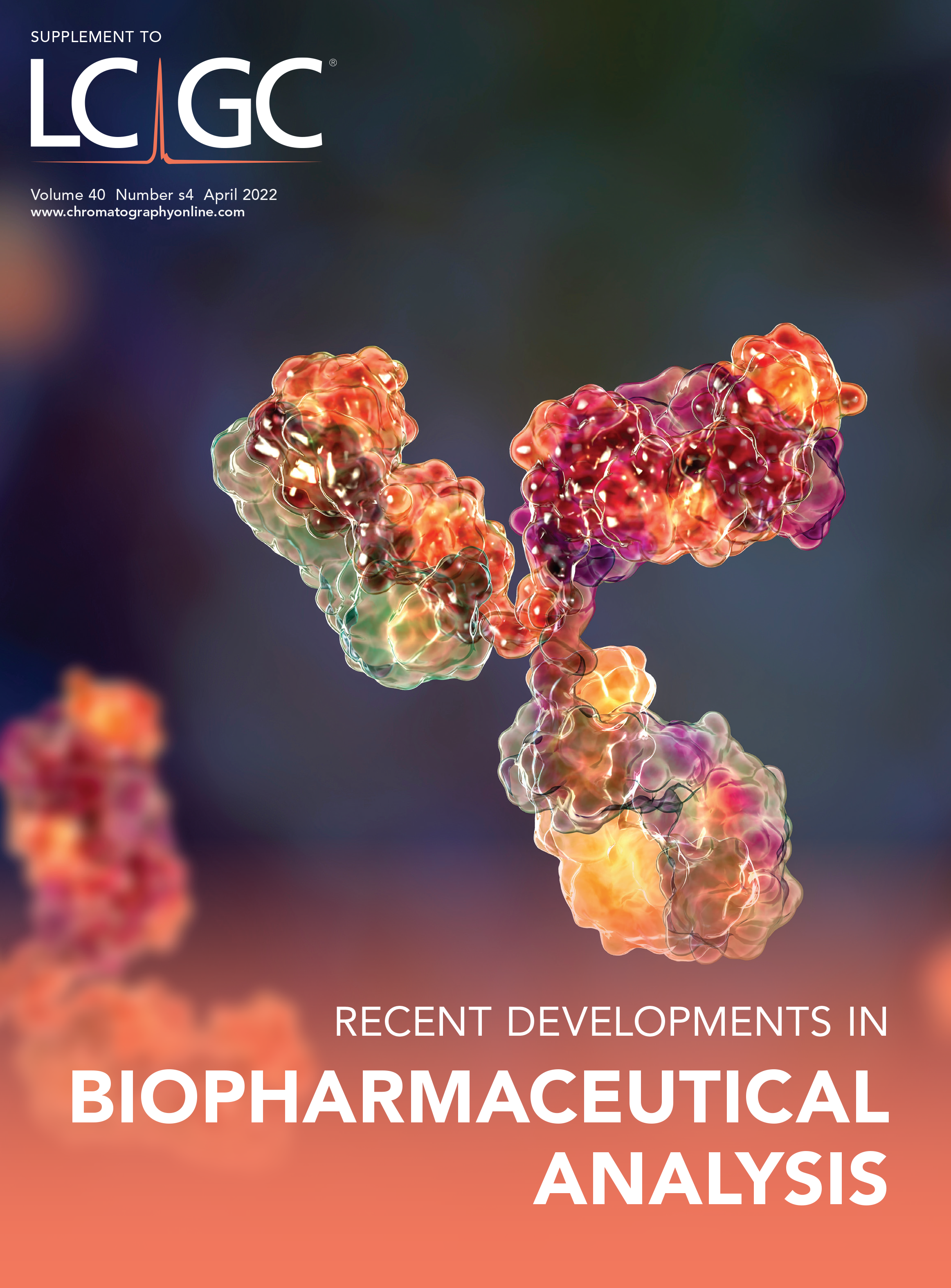The Power of Trypsin Immobilized Enzyme Reactors (IMERs) Deployed in Online MDLC–MS Applications
Immobilized enzyme reactors (IMERs) are a powerful and essential part of multidimensional liquid chromatography–tandem mass spectrometry (MDLC–MS/MS) approaches that enable online identification, characterization, and quantification of post-translational modifications of therapeutic antibodies. This review gives an overview of commercially available and selected trypsin IMERs in regard to their application in LC-based and automated sample preparation. Additionally, we address the challenges of IMER application in online systems and the advantages of self-made IMERs.
Over the past several years, online multidimensional LC–MS (MDLC–MS) has continuously drawn increased attention because of its effectiveness and speed when used to characterize therapeutic antibodies (Abs) (1,2). Various MDLC–MS approaches have been developed, optimized, and adjusted to different analytical needs to examine post-translational modifications (PTMs), such as N-glycosylation, methionine oxidation, asparagine deamidation, and aspartate isomerization (3–5). In 2021, Camperi and others (1) reviewed the potential of these automated online workflows with their broad field of application and highlighted their advantages compared to traditional offline approaches. Benefits of the automated online workflows compared to the labor-intensive offline workflows are a lower amount of protein, fewer method-induced artifacts, and less impurities and significant time savings. The protein digestion step is a crucial part of MDLC–MS/MS systems because high sequence coverages and low levels of missed cleavages are indispensable for identifying and quantifying PTMs (3). Immobilized enzyme reactors (IMERs) are the basis of these multidimensional systems. They are used to perform the online digestion and allow for fast and reproducible cleavage of antibodies into fragments (IdeS/pepsin/papainIMER) (6–9) or peptides (trypsin/LysC-IMER) (3–5, 10–11), as shown in Figure 1.
FIGURE 1: Online peak characterization by 4D-LC–MS incorporating separation and fractionation in the 1st dimension (1D), reduction or denaturation (2D), transfer and digestion on trypsin IMER (3D), and subsequent MS peptide mapping (4D).

Moreover, these IMERs enable less enzymatic autolysis, and the online in-flow digestion breaks the analysis time down to a few minutes or seconds compared to the time-consuming offline workflow that often requires overnight digestion (2–8,10–19). Even though there are various columns that incorporate enzymes, such as immobilized LysC, pepsin, papain, and IdeS, this review focuses on commercially available trypsin IMERs, which have been extensively applied in recent MDLC–MS studies (1,4–6,8,14,16–18,20).
Table I summarizes all purchasable trypsin IMERs with detailed information as well as referenced applications. In general, trypsin IMERs can be acquired from two different suppliers, namely StyrosZyme (OraChrom Inc.) or Perfinity (Perfinity Biosciences), whereas the Poroszyme trypsin IMER (ThermoFisher Scientific) has been withdrawn from the market. However, there are still functional columns in the laboratories, so it can be assumed that studies will continue to be performed utilizing this type of column.

Various publications confirmed the application of these three commercial trypsin IMERs for fast and automated sample preparation in combination with a variety of different MDLC–MS approaches (1,3–5,11–13,19,20). An interlaboratory study by Camperi and others (3) utilized Poroszyme and StyrosZyme IMERs for the ion exchange chromatography (IEC) characterization of an IgG, and it emphasized how this analytical workflow could provide high digestion reliability and performance. The three laboratories obtained comparable high sequence coverages (between 95.8–96.4%) with the two different IMERs. Nevertheless, the rates of missed cleavages were 10–11% for Poroszyme compared to 5% for StyrosZyme. The lower missed cleavage rate can be explained by the elongated length of the StyrosZyme IMER (100 mm), which leads to an extended digestion time and a consecutively higher digestion efficiency compared to the Poroszyme (50 mm). Moreover, the age and a high number of previously performed digestion cycles can induce higher missed cleavage rates compared to new IMERs.
The same two types of IMERs were further compared by Goyon and others (12) where several different Abs were analyzed with a 4D-LC–MS (IEC x RPLC x trypsin IMER x RPLC) analytical workflow. These data showed for most Abs a higher sequence coverage for the Poroszyme compared to the StyrosZyme cartridge.
In a previous work by Goyon and others (13), the size variants of an antibody–drug conjugate (ADC) were characterized by 2D-(SEC x HIC) and 4D-LC–MS (SEC x RPLC x trypsin IMER x RPLC). The 4D-LC–MS approach incorporated the Poroszyme IMER similarly to the preceding Ab characterization (12), and a sequence coverage of 93% was obtained.
Pot and others (11) presented an online peptide mapping approach without any prior separation of Ab species that achieved a sequence coverage up to 98% using the StyrosZyme IMER. A further example for the application of the StyrosZyme cartridge is the 4D-LC–MS characterization of Abs charge variants reported by Verscheure and others (5), with a sequence coverage of >95%. Here, the authors allowed up to four missed cleavages in data evaluation, result- ing in increased sequence coverage. In contrast, Reinders and others (18) evaluated the Perfinity IMER in comparison to an offline digestion approach of an Ab, demonstrating a comparably low sequence coverage between the two approaches. As previously indicated, the sequence coverage is typically used to benchmark performance. However, it needs to be pointed out that the sequence coverage is not only dependent on the quality of the IMER itself, but can also be influenced by the analytical system setup and other experimental parameters (such as digestion temperature and time, or the buffer system).
In the studies listed here, the trypsin IMERs are evaluated with varying system conditions and different types of analytes. Thus, the performance comparison of the three commercially available trypsin IMERs based on published data should be interpreted carefully when not performed within the same experimental setup and with different on-column digestion conditions. To address this concern, it would be beneficial to conduct another follow-up study. In addition, the applied analytical peptide mapping setup and data processing parameters, such as the tolerated number of missed cleavages and the set MS/MS scores for identification, play an important role. Despite that, the following considerations are valid and can be generally applied in the context of online digestion: a) higher digestion temperatures increase the activity of the enzyme on the one hand, but accelerate the aging process of the IMER on the other hand; b) the efficiency depends on the on-column digestion time and can be controlled by the flow rate and IMER dimension; c) optimization of the digestion buffer (for example, pH and salt concentration) in combination with organic solvents for ideal digestion efficiency is important; and d) a preceding denaturation or reduction improves the digestion efficiency, if applicable.
In general, all commercial IMERs achieve good results and lead to fast and efficient digestion. Nevertheless, a study comparing the two commercially available IMERs, namely StyrosZyme and Perfinity, would be valuable.
Besides the commercially available trypsin IMERs, further publications describe self-made cartridges for which the enzyme is self-immobilized onto columns. These are generally developed to either demonstrate comparable performance to offline in-solution digestion while extensively reducing the analysis time (15,21) or to benchmark with commercially available IMERs. For example, Slechtova and others (19) developed a self-immobilized silica-based IMER immobilizing trypsin on high pressure compatible with non-bonded bridge-ethyl hybrid (BEH) silica particles (5 μm, 300 Å, Waters Corporation), comparing it to the trypsin Poroszyme and Perfinity cartridges. An intensive analysis of the digestion activity and repeatability under different conditions (pH, digestion temperature, and adaptation of residence time in the cartridge by changing flow rates) showed an overall good digestion performance of all three IMERs, with the Perfinity performing slightly better than the Poroszyme and the self-made IMER, according to the authors. Based on the good results of the BEH-IMER and its stability at high pressure, this type of IMER has the potential to provide significant value in the context of MDLC–MS applications and commercialized development of this IMER would be favorable, to make this invention available to the broad public. Commercially available trypsin-IMERs typically implemented in MDLC–MS work- flows are generally stable only at low pressure; therefore, it can be challenging when combining with a subsequent peptide mapping. To overcome this challenge with commercially available IMERs, chromatographic columns with increased particle size, inner diameter, or reduced length are typically used for the peptide mapping separation (4,8,14). However, decreased chromatographic performance compared to offline peptide mapping approaches can occur, which are typically performed under high pressure.
Additionally, IMERs with trypsin immobilized on various materials such as particle suspensions, on paper, in membranes, magnetic beads, and different polymeric materials, are widely described (17,20,21) as well as the implementation of IMERs at nano-level (9,10,22), but are not discussed here.
In conclusion, the publications addressed here demonstrate the efficiency and suitability of the commercially available trypsin IMERs to perform online protein digestion, which is reflected in high sequence coverages, robustness, good repeatability, and relatively low rates of missed cleavages in respect to the significantly shorter online digestion time (3,19) compared to manual approaches. The availability of additional types of commercially available columns would ultimately expand the use of IMERs because of their capability to provide an automated sample preparation to redeem standard offline digestion, but also as an integral part of MDLC–MS workflows. Furthermore, IdeS IMERs can be used to perform protein characterization at the middle up level (1,6–8). Looking ahead, future development should address the need to cover the complete amino acid sequence of proteins, which can be achieved by the combination of multiple cartridges immobilizing diverse enzymes. To date, IMERs based on LysC (10), (Perfinity), papain (OraChrom) and pepsin (such as from Waters) are already commercially available and additional ones might hit the market soon.
References
(1) J. Camperi, A. Goyon, D. Guillarme, K. Zhang, and C. Stella, Analyst 146(3), 747–769 (2021). DOI: 10.1039/ d0an01963a.
(2) T. Graf, K. Heinrich, I. Grunert, H. Wegele, M. Haberger, P. Bulau, and M. Leiss, J. Pharm. Biomed. 186, 113251 (2020).
(3) J. Camperi, I. Grunert, K. Heinrich, M. Winter, S. Ozipek, S. Hoelterhoff, T. Weindl, K. Mayr, et al, Talanta 234, 122628 (2021). DOI: 10.1016/j.talanta.2021.122628.
(4) C. Gstöttner, D. Klemm, M. Haberger, A. Bathke, H. Wegele, C. Bell, and R. Kopf, Anal. Chem. 90(3), 2119–2125 (2018).
(5) L. Verscheure, A. Cerdobbel, P. Sandra, F. Lynen, and K. Sandra, J. Chromatogr. A. 1653, 462409 (2021) DOI: 10.1016/j.chroma.2021.462409.
(6) J. Camperi, L. Dai, D. Guillarme, and C. Stella, Anal. Chem. 92(6), 4357–4363 (2020). DOI: 10.1021/acs.analchem.9b05193.
(7) J. Camperi, D. Guillarme, M. Lei, and C. Stella, J. Pharm. Biomed. Anal. 182, 113130 (2020). DOI: 10.1016/j.jpba.2020.113130.
(8) J. Camperi, D. Guillarme, and C. Stella, Anal. Chem. 92(19), 13420–13426 (2020). DOI: 10.1021/acs.analchem.0c02780.
(9) S. Perchepied, N. Eskenazi, C. Giangrande, J. Camperi, T. Fournier, J. Vinh, et al, Talanta 206, 120171 (2020).
(10) J. Krenkova, N.A. Lacher, and F. Svec, Anal. Chem. 81(5), 2004–2012 (2009). DOI: 10.1021/ac8026564.
(11) S. Pot, C. Gstöttner, K. Heinrich, S. Hoelterhoff, I. Grunert, M. Leiss, et al, Anal. Chim. Acta 1184, 339015 (2021).
(12) A. Goyon, L. Dai, T. Chen, B.C. Wei, F. Yang, N. Andersen, et al, J. Chro- matogr. A 1615, 460740 (2020).
(13) A. Goyon, M. Kim, L. Dai, C. Cornell, F. Jacobson, D. Guillarme, and C. Stella, Anal. Chem. 91(23), 14896–14903 (2019).
(14) S. Millan-Martin, C. Jakes, S. Carillo, T. Buchanan, M. Guender, D.B. Kristensen, et al, Anal. Bioanal. Chem. 412(25), 6833–6848 (2020). DOI: 10.1007/s00216-020-02809-z.
(15) S. Moore, S. Hess, and J. Jorgenson, J. Chromatogr. A 1476, 1–8 (2016) DOI: 10.1016/j.chroma.2016.11.021.
(16) M. Naldi, U. Cernigoj, A. Strancar, and M. Bartolini, Talanta 167, 143–157 (2017). DOI: 10.1016/j.talanta.2017.02.016.
(17) F.E. Regnier and J. Kim, Bioanalysis 6(19), 2685–2698 (2014). DOI: 10.4155/bio.14.216.
(18) L.M.H. Reinders, M.D. Klassen, T. Teutenberg, M. Jaeger, and T.C. Schmidt, Anal. Bioanal. Chem. 413(28), 7119–7128 (2021). DOI: 10.1007/s00216-021-03683-z.
(19) T. Slectova, M. Gilar, K. Kalikova, S.M. Moore, J.W. Jorgensen, and E. Tesarova, J. Chromatogr. A 1490, 126–132 (2017). DOI: 10.1016/j.chroma.2017.02.024.
(20) G. Massolini and E. Calleri, J. Sep. Sci. 28(1), 7–21 (2005).
(21) H. Yamaguchi and M. Miyazaki, Proteomics 13(3–4), 457–466 (2013).
(22) J. Sproß and A. Sinz, Anal. Chem. 82(4), 1434–1443 (2010).
Anja Bathke (pictured), Sina Hoelterhoff, and Saban Oezipak are with Pharma Technical Development at F. Hoffmann-La Roche, in Basel, Switzerland. Ingrid Grunert, Katrin Heinrich, and Martin Winter are with Pharma Technical Development at Roche Diagnostics GmbH, in Penzberg, Germany. Direct corresponding to Anja Bathke at anja.bathke@roche.com.


Accelerating Monoclonal Antibody Quality Control: The Role of LC–MS in Upstream Bioprocessing
This study highlights the promising potential of LC–MS as a powerful tool for mAb quality control within the context of upstream processing.
Common Challenges in Nitrosamine Analysis: An LCGC International Peer Exchange
April 15th 2025A recent roundtable discussion featuring Aloka Srinivasan of Raaha, Mayank Bhanti of the United States Pharmacopeia (USP), and Amber Burch of Purisys discussed the challenges surrounding nitrosamine analysis in pharmaceuticals.

.png&w=3840&q=75)

.png&w=3840&q=75)



.png&w=3840&q=75)



.png&w=3840&q=75)













